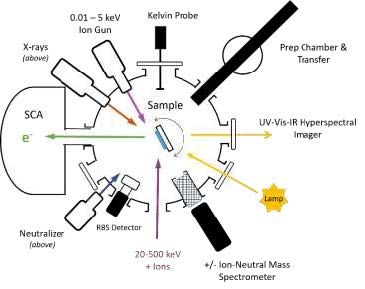KEVION GRAINS Chamber
GRAINS: A Multi-technique UHV Analytical Chamber
Under development - Expected online Fall 2024

The GRAINS chamber is designed to enable comprehensive analytical measurement and monitoring of surface (1–3 monolayers, ML), near-surface (to ~10 nm depth) and bulk (to ~10 µm depth) material characteristics by SIMS, XPS, RBS, and UV-Vis-NIR optical reflectance (or transmission). Additional instrumentation, such as a low-energy ion gun for sputter depth profiling or low-energy irradiations (0.2 - 5 keV), dual charge neutralization, and/or electron irradiation (0.2-5 keV) are available. Multiple, integrated analytical techniques on the same chamber eliminates the need to transfer samples between systems, thereby reducing the logistic complexity of such experiments as well as the risk of contamination due to atmospheric exposure. Sample resistive heating and LN2-cooling (120-900K) for varied analytical measurements is designed into an existing sample stage modified to accept transferred samples.
Dual-Anode Small Spot X-ray Photoelectron Spectroscopy (XPS)
The SPECS imaging X-ray spectroscopic micrometer with FOCUS 500 (Rowland circle = 500 mm dia.) dual-anode (Al: 1486.6 eV & Ag: 2984.3 eV for HAXPES) monochromated X-ray source and 2D-CMOS detector will provide quantitative elemental and chemical maps of sample surfaces. An electron flood gun for surface charge neutralization is included in the GRAINS chamber system (above). The XPS information depth with Al X-rays is ~10 nm and up to ~20 nm with Ag X-rays for some elements (e.g. Al, Si, Cl, S, P). These depths are well matched to the penetration depth of 1 keV/amu protons/helium and a low-energy sputter-type gun is mounted to the chamber to explore more deeply into and through the damage region.
Medium-Energy Rutherford Backscattering (RBS)
The Rutherford Backscatter detector system from Ametek/Ortec will be used to determine depth-dependent compositional profiles of target materials down to several microns, including hydrogen detection in elastic/forward scattering mode. The system utilizes an ULTRA-AS ion-implanted-silicon charged particle detector with 19.5 mm active area diameter, ~100 um depletion depth, and a thin (500 Å) boron-implanted entrance contact to minimize energy loss prior to an ion entering the depleted region. RBS can be utilized for examination of layered materials, or measurement of isotopic distributions, or diffused species [e.g. Cherniak and Watson, 1992].
Ion (+/-) / Neutral Mass Spectrometer (SIMS)
A Hiden EQS 300 Secondary Ion Mass Spectrometer will be used for determination of surface elemental composition (within the top 1–2 monolayers) for species ≤ 300 amu, including protons. The spectrometer is sensitive to both positive and negative ions and includes an electron impact ionization source for the detection of neutral species. This instrument can be utilized for secondary-ion production studies, surface composition determination, and in some cases, low-energy ion backscattering [e.g. Schaible et al. 2017; Elphic et al. 1991].
Kelvin Probe
The KP Technologies UHVKP020 Kelvin Probe is a UHV-compatible, retractable, non-contact, non-destructive vibrating capacitor device with 2 mm dia. gold mesh tip, used to measure the work function of conductive materials or the surface potentials of semiconductors and insulating surfaces with a resolution of 1–3 meV. It can be used for in situ measurement of surface charge and differential surface charge on ices, minerals, and grains.
UV-Vis-NIR Hyperspectral Imaging
The Malvern Analytical FieldSpec 4 Hi-Res hyperspectral imager collects high resolution (3 nm @ 700 nm / 8 nm @ 1400/2100 nm), in situ bi-directional diffuse reflectance spectra from sample surfaces across the UV-Vis-NIR range from 350–2500 nm. The ASD FieldSpec is the gold standard for hyperspectral imaging/reflectance measurement of geologic materials [Jiang et al. 2022; Sun et al. 2021]